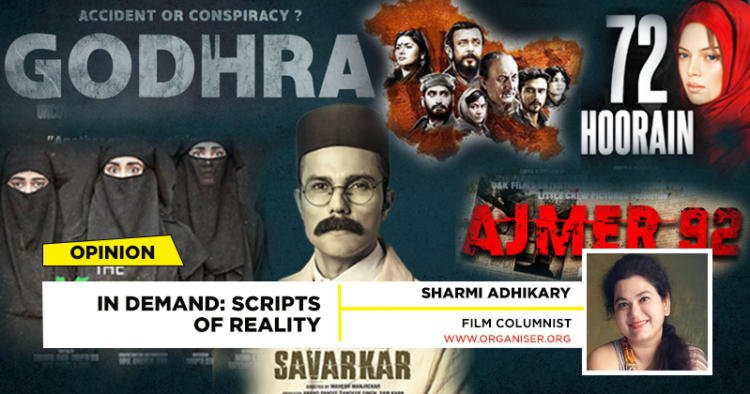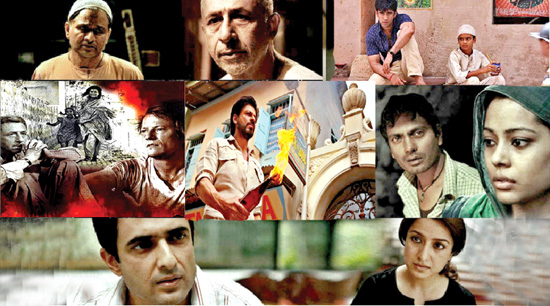When the ghastly second wave of the COVID-19 pandemic was ebbing in India, a friend of mine made a remark about the pitiable collections that mainstream Bollywood films were making at the box office. “I don’t think the abysmal revenues have anything to do with the content of the films. It’s just that people are wary of stepping out after the coronavirus scare. They would rather watch films in the safety of their homes on OTT platforms. That medium is another reason why most aren’t really interested in paying a humongous amount for tickets in a plex. Add the popcorn and it’s quite a burn for the pocket!”
All these reasons sounded pretty rational at that point of time. Till, of course, The Kashmir Files (TKF) hit the screens. Released in a paltry number of screens in the country, Vivek Ranjan Agnihotri’s drama on the Kashmiri Pandit genocide and exodus in 1990s went on to become one of the biggest money spinners last year after garnering about Rs 250 crores.
This despite the incessant discrediting of the feature film, constant brickbats against the makers and anyone associated with the movie and mainstream discussions targeted at rubbishing the film as mere propaganda aimed at stoking communal disharmony.
However, authentic historical research backed the film massively. Word of mouth publicity helped too. And of course the response of the audience who were floored by the stark truth depicted. Not to mention the heart wrenching performances of the cast, especially by Anupam Kher and Darshan Kumar. The former representing the relic of a cruel past and the later a mirror to what the youth of our country must know and question today. The massive returns collected by TKF proved that people had woken up from their slumber of pseudo secularism and were hankering for legit answers to questions the previous powers-that-be had conveniently brushed under the carpet.
The reality is that none of these films are Islamophobic. Rather, they delve into the major issue of terror and its ideology. Anyone trying to rubbish these important works of cinema is misleading impressionable youth
The audience was fed up with films where Islamic Invaders were glorified as heroes as well as the repeated presentation of propaganda that of how ISIS handlers penetrate mainstream educational institutions in Kerala from where Hindu and Christian girls are ultimately sabotaged the reality about grave political events and incidents. They were in the mood to acknowledge the real heroes as against the propped up ones while disrobing the fiends and exposing the reasons for turmoil unleashed on Bharat for centuries.
Film directors who would never attempt to make films on certain subjects are writing scripts that are ruffling the Leftist echo chamber. After each such film announcement, social media attacks are channelised to demoralise the makers. For instance, though Sidhharth Anand’s Pathaan presented fictional bunkum about a reel Pathaan saving the country indoctrinated and packed off to Syria to join the cause of war.
Leftist handles labelled the film as ‘Islamophobia’ even as they stayed tight lipped about pertinent questions as to how can sex and war crimes unleashed by ISIS be justified as part of Islam? When they were shown the mirror as to how the narrative also blamed deracination of Hindus for what was happening in Kerala by supporting the arguments with Yazidi girls being held hostage as sex slaves, mum was the word inside the echo chambers.
Says Sanjay Puran Singh, the National Award winning Director of the upcoming 72 Hoorain, another film facing the from terrorists (despite the historical proof of real Pathaans being ardent enemies of Bharatiya Hindus since centuries), paid reviews ensured the film was praised irrespective of the anomalies in script, presentation and aesthetics. On the other hand, Sudipto Sen’s The Kerala Story was ripped apart by the pseudo-liberal ecosystem on flimsy grounds. The film exposed the criminal face of radical Islam by presenting a threadbare account flak from the pseudo-liberal cult, “In the years before 2014, India, as well as the world, were gripped by a series of devastating terror attacks. This forced us to confront the chilling reality that countless lives could be claimed by the actions of those convinced to commit such atrocities. Determined to shed light on this dark subject, I delved into extensive research, and to my astonishment, uncovered a disturbing common thread—a doctrine known as the “72 hoorain”, a twisted proposition offered in exchange for the sacrifice of life.” As opposed to what the critics are saying, Singh’s film exposes the dangers of fundamentalism and is not necessarily discrediting the faith itself. It will be baring facts about dreaded terror kingpins who unleashed pain and suffering on the world. Now, why would anyone want to turn apologist for evil people like that? What could be their reason to justify such crimes?
The reality is that none of these films are Islamophobic. Rather, they delve into the major issue of terror and its ideology. Anyone trying to rubbish these important works of cinema is misleading impressionable youth. For years, such narrative-setters have been instrumental in covering up the doctrine and referring to it as ‘resistance’. No wonder they glorify murderers like Yasin Malik and whitewash the crimes of goons like Atiq Ahmed, Haseena Parker and Mukhtar Ansari.
The 1992 event was never allowed to be brought out in mainstream consciousness till a few years ago when Twitter room threads shed light on the communal nature of the hateful incident. Pushpendra Singh’s upcoming movie Ajmer 92 will be a detailed analysis of what had happened. It is sure to set the Leftist tongues wagging again, which should also prove that the ground is slipping from beneath their systematically constructed towers of hypocrisy and propaganda. Despite the half-baked truths and imbalanced narratives dished out in films such as Nandita Sen’s Firaaq, Rahul Dholakia’s Parzania and Abhishek Kapoor’s Kai Po Che, they were applauded and made popular by PR campaigns. Then why wouldn’t the same coterie give a chance to 72 Hoorain, Ajmer 92, or Godhra, another upcoming film that will reveal what exactly triggered the riots in 2002?
It is easy to brainwash an audience who isn’t well versed with authentic history. But when people make honest effort to be informed about the past and take active interest in socio-political discussions to gauge narratives being set, there comes a time when all kinds of agenda-oriented art falls flat. Perhaps that is why Bollywood is witnessing unprecedented low income while smaller films are doing better. It is the thread of genuineness that is bolstering their case. Post 2014, people have been privy to well researched books and articles on personalities and events that were earlier difficult to access. This has cleared the air on a lot of subjects. For instance, Veer Savarkar was a much maligned name till a few years ago. Not anymore. The Leftists may deride Randeep Hooda with snide remarks like, “He’s trying to revive his failing career with such a film” but the actor’s directorial venture Swatantrya Veer Savarkar is a most awaited movie on the revolutionary. Such a film would have bitten dust before 2014.
Awareness and acceptance of counter narratives have grown in Bharat, a country that today realises the importance of authentic history and a balanced political discourse. It is this desire to delve into the truth that has sprouted renewed interest in films such as Shoojit Sircar’s Sardar Udham. The success of movies like RRR and Malikappuram, bearing testimony to the surge of nationalistic fervour among Indians. Similar is the case of Ram Vamsi Krishna’s The India House. For the uninitiated, India House was a student residence that existed between 1905 and 1910 at Cromwell Avenue in Highgate, North London. With the patronage of lawyer Shyamji Krishna Varma, it was opened to promote nationalist views among Indian students in Britain. Now tell me, do you think this movie would get any traction pre-2014? Well, you and I, we both know the answer.
Sharmi Adhikary is a senior lifestyle journalist and columnist with a yen for exploring interesting concepts in fashion, culture and cinema.
























Comments